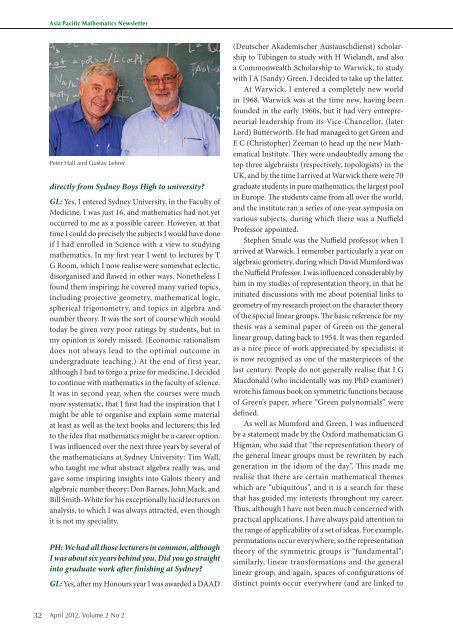Mathematics Newsletter
Mathematics Newsletter
Mathematics Newsletter
You also want an ePaper? Increase the reach of your titles
YUMPU automatically turns print PDFs into web optimized ePapers that Google loves.
32<br />
Asia Pacific <strong>Mathematics</strong> <strong>Newsletter</strong><br />
Peter Hall and Gustav Lehrer<br />
directly from Sydney Boys High to university?<br />
GL: Yes, I entered Sydney University, in the Faculty of<br />
Medicine. I was just 16, and mathematics had not yet<br />
occurred to me as a possible career. However, at that<br />
time I could do precisely the subjects I would have done<br />
if I had enrolled in Science with a view to studying<br />
mathematics. In my first year I went to lectures by T<br />
G Room, which I now realise were somewhat eclectic,<br />
disorganised and flawed in other ways. Nonetheless I<br />
found them inspiring; he covered many varied topics,<br />
including projective geometry, mathematical logic,<br />
spherical trigonometry, and topics in algebra and<br />
number theory. It was the sort of course which would<br />
today be given very poor ratings by students, but in<br />
my opinion is sorely missed. (Economic rationalism<br />
does not always lead to the optimal outcome in<br />
undergraduate teaching.) At the end of first year,<br />
although I had to forgo a prize for medicine, I decided<br />
to continue with mathematics in the faculty of science.<br />
It was in second year, when the courses were much<br />
more systematic, that I first had the inspiration that I<br />
might be able to organise and explain some material<br />
at least as well as the text books and lecturers; this led<br />
to the idea that mathematics might be a career option.<br />
I was influenced over the next three years by several of<br />
the mathematicians at Sydney University: Tim Wall,<br />
who taught me what abstract algebra really was, and<br />
gave some inspiring insights into Galois theory and<br />
algebraic number theory; Don Barnes, John Mack, and<br />
Bill Smith-White for his exceptionally lucid lectures on<br />
analysis, to which I was always attracted, even though<br />
it is not my speciality.<br />
PH: We had all those lecturers in common, although<br />
I was about six years behind you. Did you go straight<br />
into graduate work after finishing at Sydney?<br />
GL: Yes, after my Honours year I was awarded a DAAD<br />
April 2012, Volume 2 No 2<br />
(Deutscher Akademischer Austauschdienst) scholarship<br />
to Tübingen to study with H Wielandt, and also<br />
a Commonwealth Scholarship to Warwick, to study<br />
with J A (Sandy) Green. I decided to take up the latter.<br />
At Warwick, I entered a completely new world<br />
in 1968. Warwick was at the time new, having been<br />
founded in the early 1960s, but it had very entrepreneurial<br />
leadership from its Vice-Chancellor, (later<br />
Lord) Butterworth. He had managed to get Green and<br />
E C (Christopher) Zeeman to head up the new Mathematical<br />
Institute. They were undoubtedly among the<br />
top three algebraists (respectively, topologists) in the<br />
UK, and by the time I arrived at Warwick there were 70<br />
graduate students in pure mathematics, the largest pool<br />
in Europe. The students came from all over the world,<br />
and the institute ran a series of one-year symposia on<br />
various subjects, during which there was a Nuffield<br />
Professor appointed.<br />
Stephen Smale was the Nuffield professor when I<br />
arrived at Warwick. I remember particularly a year on<br />
algebraic geometry, during which David Mumford was<br />
the Nuffield Professor. I was influenced considerably by<br />
him in my studies of representation theory, in that he<br />
initiated discussions with me about potential links to<br />
geometry of my research project on the character theory<br />
of the special linear groups. The basic reference for my<br />
thesis was a seminal paper of Green on the general<br />
linear group, dating back to 1954. It was then regarded<br />
as a nice piece of work appreciated by specialists; it<br />
is now recognised as one of the masterpieces of the<br />
last century. People do not generally realise that I G<br />
Macdonald (who incidentally was my PhD examiner)<br />
wrote his famous book on symmetric functions because<br />
of Green’s paper, where “Green polynomials” were<br />
defined.<br />
As well as Mumford and Green, I was influenced<br />
by a statement made by the Oxford mathematician G<br />
Higman, who said that “the representation theory of<br />
the general linear groups must be rewritten by each<br />
generation in the idiom of the day”. This made me<br />
realise that there are certain mathematical themes<br />
which are “ubiquitous”, and it is a search for these<br />
that has guided my interests throughout my career.<br />
Thus, although I have not been much concerned with<br />
practical applications, I have always paid attention to<br />
the range of applicability of a set of ideas. For example,<br />
permutations occur everywhere, so the representation<br />
theory of the symmetric groups is “fundamental”;<br />
similarly, linear transformations and the general<br />
linear group; and again, spaces of configurations of<br />
distinct points occur everywhere (and are linked to


